Indonesia, with its vast archipelago of more than 17,000 islands, is a country rich in cultural diversity. This diversity extends to its traditional transportation methods, which have been used for centuries to navigate the diverse landscapes of the country. In this blog post, we will explore 10 famous traditional transportation methods in Indonesia, each with its own unique charm and cultural significance.
1. Becak or Rickshaw
 |
| Becak |
One of the most iconic forms of traditional transportation in Indonesia is the becak or Called Rickshaw, a three-wheeled cycle rickshaw. Found mainly in urban areas, becaks are a popular mode of transportation for short distances. The passenger sits in a small carriage at the front of the becak, while the driver pedals from behind. Becaks are not only a convenient means of transportation but also a great way to experience the hustle and bustle of Indonesian cities.
2. Dokar
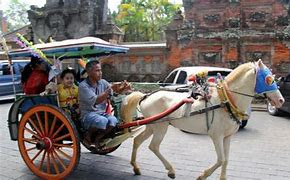 |
| Dokar |
Originating from the island of Java, the dokar is a traditional horse-drawn carriage that is still used in some rural areas. Typically made of wood and bamboo, the dokar is a charming and nostalgic mode of transportation. It offers a slower pace of travel, allowing passengers to enjoy the scenic countryside and immerse themselves in the local culture.
3. Andong
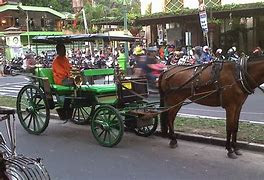 |
| Andong |
Similar to the dokar, the andong is a horse-drawn carriage commonly found in the city of Yogyakarta. It is often used to transport tourists around the city's famous landmarks, such as the Sultan's Palace and the Water Castle. The andong is adorned with intricate carvings and colorful decorations, making it a sight to behold. Riding in an andong is not only a means of transportation but also an opportunity to experience the rich history and heritage of Yogyakarta.
4. Cidomo
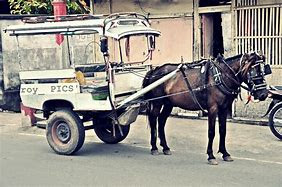 |
| Cidomo |
In the Gili Islands, a popular tourist destination in Indonesia, the cidomo is the main mode of transportation. The cidomo is a horse-drawn cart, similar to the dokar, but with a larger carriage to accommodate more passengers. As motorized vehicles are not allowed on the islands, the cidomo provides a unique and eco-friendly way to explore the beautiful beaches and vibrant nightlife of the Gili Islands.
5. Bemo
 |
| Bemo |
Bemos are small minivans that serve as a form of public transportation in many cities and towns across Indonesia. These colorful and often overcrowded vehicles are a common sight on the streets, and they offer an affordable and convenient way to get around. While bemos may not be the most comfortable mode of transportation, they provide an authentic Indonesian experience and a chance to interact with the locals.
6. Jukung
 |
| Jukung |
Indonesia's vast coastline and numerous islands make fishing a significant part of the country's culture and economy. Jukungs, traditional fishing boats, are commonly used by fishermen in coastal areas. These small wooden boats are typically painted in bright colors and decorated with intricate carvings. Jukungs are not only used for fishing but also for transportation between islands, offering a scenic and adventurous way to explore Indonesia's coastal regions.
7. Perahu
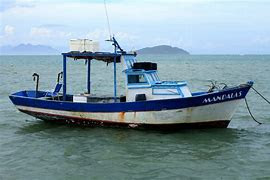 |
| Perahu |
Perahu, or traditional wooden boats, are a common sight in Indonesia's rivers and lakes. These boats are used for various purposes, such as transportation, fishing, and even tourism. Perahu vary in size and design depending on the region, with some boats capable of accommodating large groups of people. Taking a ride on a perahu allows travelers to witness the stunning natural beauty of Indonesia's waterways and provides a peaceful and serene mode of transportation.
8. Delman
 |
| Delman |
Delman, also known as bendi, is a traditional horse-drawn carriage that was once a popular mode of transportation in major cities like Jakarta and Surabaya. While delman carriages have become less common in recent years due to the rise of motorized vehicles, they can still be found in some tourist areas and are occasionally used for ceremonial purposes. Riding in a delman offers a nostalgic glimpse into Indonesia's colonial past and a chance to appreciate the country's rich history.
9. Gerobak
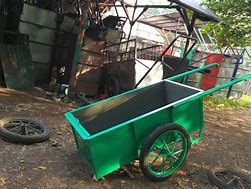 |
| Gerobak |
Gerobak, or pushcarts, are a common sight in Indonesian markets and street food stalls. These carts are used by vendors to transport their goods and are often brightly decorated with colorful umbrellas or banners. Gerobak are an essential part of Indonesia's street culture and offer a convenient way for vendors to sell their products while navigating crowded streets. Exploring the bustling markets and sampling delicious street food from a gerobak is a must-do experience for any visitor to Indonesia.
10. Becak Motor
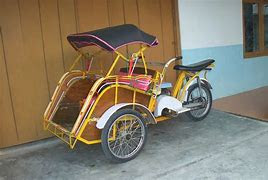 |
| Becak Motor |
A modern twist on the traditional becak, the becak motor is a motorized version of the cycle rickshaw. It is commonly found in cities like Medan and Palembang, where it serves as a popular mode of transportation for short distances. The becak motor retains the charm of the traditional becak while offering a faster and more efficient way to get around in urban areas.
Another Articles About Transportation
- 10 Traditional Transportation In Indonesia
- 10 Top Most Expensive Cars In The World
- 5 Top Hybrid Car Sales in Indonesia on 2023
- 5 Top Electrics Car Sales in Indonesia on 2023
In conclusion, Indonesia's traditional transportation methods are not only practical means of getting from one place to another but also a reflection of the country's rich cultural heritage. From horse-drawn carriages to colorful pushcarts, each mode of transportation offers a unique experience and a chance to immerse oneself in the local culture. Whether exploring the bustling streets of Jakarta or the serene waters of Bali, traditional transportation in Indonesia is an integral part of the country's identity and a must-try for any visitor.
Post a Comment for "10 Famous Traditional Transportation in Indonesia"